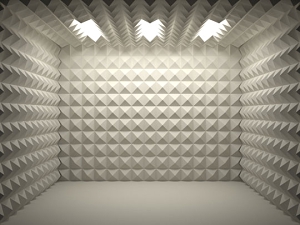 Audio recording is a challenging yet enjoyable and fulfilling task. Newbies often overlook the importance of having a properly treated room.
Audio recording is a challenging yet enjoyable and fulfilling task. Newbies often overlook the importance of having a properly treated room.
As such they sometimes end up with recordings that are heavy on reverb and sound slightly harsh regardless of the equipment they use for recording and mixing.
Most people use a bedroom, garage or even a corner in the living room as a home studio. Such places are not designed for pro audio use hence to get the best out of them you may need to invest in acoustic treatment.
Beginner Guide to Acoustic Treatment and Soundproofing
In this post, we’ll go through the process of designing and setting up acoustic treatment that will help solve some of your recording challenges.
What is acoustic treatment?
 Acoustic treatment refers to managing the acoustics of a room.
Acoustic treatment refers to managing the acoustics of a room.
Acoustic treatment is used disperse reflections and to dampen reverberation in a room to provide as accurate a sound as possible.
Having a lot of reverb in a place can make it difficult to listen to and mix sound accurately because reverb in the room can fool the ears into thinking that all the sound that you’re hearing is coming from your favorite pair of studio speakers.
Hence it can lead you to make misinformed decisions when mixing your audio.
What’s the problem with having a lot of reverberations in your room?
Reverberations can affect your recording as your microphone can capture these. Hence the final result will be the artist’s voice as well as the sound of the room, which is sometimes undesired, especially for a lot of modern music.
Some rooms are difficult to mix in because they’re prone to bass build up. Acoustic treatment can also solve this problem and help dampen a room to make it more suitable for mixing audio in.
How does room treatment differ from soundproofing?
 Acoustic treatment should not be mistaken for soundproofing.
Acoustic treatment should not be mistaken for soundproofing.
Soundproofing aims to make your room resistant to sound so that no unwanted sound enters or leaves the room.
This is achieved by lining the walls, doors, ceiling, floors and any spaces around the room to ensure no sound travels out.
As you can see from the above definition acoustic treatment is not the same as soundproofing.
Why should you acoustically treat your room?
You should acoustically treat your room if you want to create an environment where the audio is balanced and not profoundly affected by reverberations.
Unless you’re recording a band, orchestra or voice in a room where you want the reverberations to be captured you need to treat your room.
Acoustic treatment will result in a flatter, more accurate sound reproduction in your room.
When are room reverberations a good thing?
Take note that reverberations are sometimes a desirable thing and some studios have become famous for the sound of their rooms, such as Abbey Roads Studio which was made famous by the Beatles.
So reverberations are not necessarily a bad thing. However, they have to be controlled to your liking, and acoustic treatment can help you achieve the sound you want.
How To Acoustically Treat Your Room
Evaluating your room
You need to evaluate your room before eagerly buying acoustic foam and bass traps to ensure you get the right tools to meet your needs. There are several things you need to take note of:
- What’s the shape of your room? A room with more corners may cause more issues than a room with fewer corners since corners are well-known for causing bass to build up.
- How big is your room? A bigger room is more prone to reverberations than a smaller room and thus may require a bigger investment in materials. However, a bigger room may not be as prone to bass build-up as a small room since the sound in a bigger room has a further distance to travel.
- What materials are your walls, floors, and ceiling made of? You need to evaluate how you will install the acoustic treatment materials based on the make-up of your room.
What techniques are used when acoustically treating a room?
When acoustically treating your room you’re looking at utilizing two main techniques:
- Absorption of sound: this technique involves setting up the room in such a way that any sound that hits certain objects should be absorbed. Material such as foam and firm mineral wool possess absorptive qualities. They soak up the sound by turning it into heat energy via friction.
Absorption is particularly effective on high-frequency sounds though it can also work on low frequencies if the right material is used. It can help dampen the sound of a ringing room.
Absorption can also be applied to contain low-frequency energy using a bass trap. A bass trap is a material typically made from a combination of various thick, thin, hard and soft materials in conjunction with air to dampen bass.
- Diffusion of sound: this technique works by scattering sound energy thereby preventing an ugly slap back from hitting you when the sound bounces off the wall. Diffusers are normally made of plastic, wood or polystyrene. Diffusion works best for controlling mid and high frequencies. It can also help improve the overall sweet spot image which should ultimately help you create better mixes.
How to plan the acoustic treatment setup for your room
It’s a good idea to plan how you’ll treat your room. First, you need to identify problem areas. You can do this by playing back a well-balanced reference track and moving around the room to identify weak spots. You could also place a good studio microphone in various areas of the room and make a short recording. Then you can evaluate how sound is picked up in those spots. That can be a great way of finding flawed areas.
Creating a model/diagram of your room
You should list down the problems of each part of the room in detail for your reference. It’s advisable to draw a sketch of your room and label all the problem areas for easier planning. You could even use a 3D modeling program if you have the time and know how. Since this is a long-term change, it’s good to get it right for the first time so that once the room is treated, you can just concentrate on making great music.
Installing bass traps
Bass is notoriously problematic, especially in small rooms. It can quickly build up, and it’s the first thing you need to take care of when treating your room. Porous bass traps can absorb mid and high frequencies. In some instances, you may find that installing bass traps may sort out the majority of your room problems.
There are two types of bass traps:
- Porous absorbers: these are made from dense materials such as foam, rock wool or fiberglass. They offer what is known as broadband absorption which means that they can pretty much absorb audio from the entire frequency spectrum. For these to be very effective in trapping bass, they need to be thick or placed far from the wall, which is not feasible if your room is small. So that’s something you need to look out for before buying some.
- Resonant/Pressure absorbers: these are specially built for handling bass problems. They offer narrowband absorption which means that they only deal with one part of the frequency spectrum. They work best when placed directly on the wall, meaning they take up less space in the room.
Porous and resonant absorbers can be installed side by side in a room. However, for a home studio, it’s best to use porous absorbers because they are cheaper to install, they don’t need much customization.
Assuming that you’re going to get porous bass traps you need to choose either between panel bass traps or corner bass traps.
What are panel bass traps?
These absorb sound by leaving a space between the panel and your wall. These use less material than corner bass traps.
What are corner bass traps?
These cover the entire space in which they’re placed. They have the advantage of being considerably heavier, which helps in absorbing bass.
Which type of bass traps should you use?
You can use whichever method tickles your fancy. They’ll both do the job. Depending on the size and shape of your room, you may need anywhere from 8 to 24 bass traps, if not more. If money is an issue you can start with the bare minimum of 4 to install in the main corners of your room and you can add to these with time.
Avoid installing bass traps without carrying out frequent listening tests from your workstation. Installing them wrongly may negatively affect the sound in your room. Your room may become too flat and dull, which is also not a desired property.
Bass traps are the single most important component when acoustically treating a room. So try your best not to skimp on them.
Installing diffusers and acoustic panels
Once absorption is handled, we can move on to installing diffusers and acoustic panels. Diffusers come in various shapes and sizes, but the most popular company by far is Auralex. Diffusers will normally be mounted on walls around the room.
First and foremost you need to ensure the area behind your workstation, particularly your monitors, is covered. So you should mount some acoustic panels directly behind them. This is very important if your speakers have a rear bass port.
You may need to cover anywhere from 20% to 80% of your room with acoustic panels to get optimal sound. But it’s possible to use less. Test the acoustics in the room after each panel is installed.
After installing one panel on a wall, you do not need to install another one directly opposite it on the parallel wall as one panel will handle reflections in that line adequately. Lay the panels out as if on a chess board, i.e., one side of the wall should only fill what would be the black squares and on the opposite side fill in the missing pieces.
Mounting panels on the walls can be a very messy task if you don’t plan well. Ensure that you measure multiple times before mounting any panel on the wall otherwise you could ruin the paint or even the panels themselves.
Extra tips to improve the sound in your room
- Decouple your speakers from the surface they’re sitting on by placing them on isolator pads. This will prevent them from shaking up the furniture, hence ensuring that you’re not listening to the furniture vibrating, which can fool you. It also prevents excess low-frequency energy from flowing into other rooms.
- Use a reflection filter (aka portable recording booth) when recording vocals to reduce reflections. A reflection filter is a studio component which sits directly behind your microphone and keeps out excess noise as well as reverb from getting into your recordings. It’s made of acoustic foam.
- In conjunction with the above tip, you should also try to get the performer to stand as close to the mic as possible without distorting or affecting the performance. The hotter the signal from the performer the less the microphone captures the room.
- As mentioned earlier, empty spaces and corners in your room can be your worst enemy so try your best to fill them up with objects that reduce their negative effects on your recordings and mixes. Having absorbent furniture such as a big couch in your room also helps to fill up space and reduce reflections.
- Laying a carpet on the floor is another way of flattening the sound in your room. The floor is one of the biggest open surfaces in your room and can lead to a lot of reflections which can make their way into your microphone. They can also affect the way sound reaches your ears and fool you. A carpet acts as an absorbent; hence it can reduce reflections.
- You can also line your room with blankets, duvets or some other thick material to help absorb some excess sound. This is not necessarily the best solution since it doesn’t look good and can be cumbersome but if you’re in a fix, it might help.
- You could also use mattresses to reduce reflections and absorb sound energy. Building a sound booth made of mattresses is a well-known DIY solution to reducing audio reflections. While this isn’t a graceful solution it could help you eliminate some acoustic problems in your room as you wait to purchase acoustic foam. You should look towards sorting out your problems once and for all so that your full attention is channeled towards creating, recording, mixing and mastering audio and your songs to the best of your ability.
- Don’t overdo acoustic treatment. You don’t want to kill the acoustics of the room completely. After all most people don’t listen to music in acoustically treated environments, so it’s wise to leave a little for natural sound to flow.
- Frequently review your home studio setup. Over time the acoustics of your room may change as you purchase new audio gear, get rid of gear from your studio, rearrange furniture, etc. You should make it a habit to periodically check the acoustics of your room to ensure you’re getting the best possible sound from it.
Conclusion
Acoustic treatment could quite possibly be the single best investment you make in your home studio. An acoustically treated room allows you capture cleaner recordings as well as listen to mixes in a well-balanced environment. Great gear is not as effective as it can be if it’s not used in the right environment. So do yourself a favor and get your home studio acoustically treated so that you can enhance the audio quality of your studio setup.
Where Can You Get Acoustic Foam For Your Home Recording Studio?
As previously stated there are many options when it comes to buying acoustic foam to treat your room. Below is a nice list of resources you can buy to get you started on your journey towards acoustically treating your audio workspace.
- SE Electronics Reflexion Filter Pro Ambience Control
- Auralex Acoustics Tubetak Pro Liquid Adhesive
- Auralex LENRD Bass Trap
- Auralex Sonolite Bass Trap
- Mybecca 96 Pack Acoustic Panels Studio Foam
- Auralex Designer Series Treatment 114 Acoustic panels
- Auralex Sonoflat 2ft²
- Auralex Acoustics MoPAD Monitor Acoustic Isolation Pads


 (93 votes, average: 3.83 out of 5)
(93 votes, average: 3.83 out of 5)